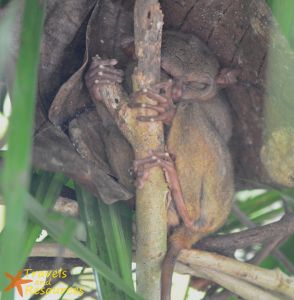 I never get tired of channels like the Animal Planet and National Geographic; just when I learn something new, they come up with a new discovery. However, viewing something on television, while quite enlightening, simply cannot compare to seeing it in person.
I never get tired of channels like the Animal Planet and National Geographic; just when I learn something new, they come up with a new discovery. However, viewing something on television, while quite enlightening, simply cannot compare to seeing it in person.
This is where the Tarsier Conservation Area in Bohol comes in. By exposing people to the Philippine Tarsier, the center hopes to develop a better appreciation for these diminutive and delicate creatures.
Table of Contents
Philippine Tarsier
Information found at the Philippine Tarsier Foundation indicates that the Philippine Tarsier is considered to be one of the smallest primates in the world. Its ancestors can be traced back as far as 45 million years. Furthermore, it is one of the oldest species that has enjoyed continuous existence in the country.

Sign
Since a typical adult is no longer than 100 millimeters, one of the first things that people say when they see a sleeping creature is that they look cute and cuddly. Interestingly, the tail can be twice as long as its body, with males having ones as long as 290 millimeters.
However, when it opens its eyes, which happen to be bigger than its brain, and rotates its head 180 degrees to face its back, most people begin to develop a different opinion about them.
The big eyes of the Philippine Tarsier makes it an ideal nocturnal hunter for insects, worms, lizards, and small fish. Hunting at night is great because most of its prey is sleeping. It also means that it does not have to compete with other predators like birds.
Eating approximately 12 grams of food a day means that a single one can rid the world of a little under 4.4 kilograms of bugs and worms in a year.
Endangered Species
Based on a study conducted by the Philippine Tarsier Foundation, only around 700 are left in Bohol. And faced with several problems, their number may be dwindling even further.
Some of the problems they face include:
- The destruction of its habitat
- The introduction of house cats to its environment
- The burgeoning pet trade around the world
The destruction of its habitat
Based on one study, a male requires a little over 6 hectares while a female require a little over 2 hectares of forest area in order to survive.
Unfortunately, the ever increasing population has seen the destruction of the Tarsier’s habitat in order to provide less expensive places to live in.
Apart from lessening the number of prey they feed on, the removal of dense bushes means it becomes increasingly difficult to hide from natural predators while it sleeps in the day and hunts at night.
The introduction of house cats to its environment
Armed with nocturnal eyesight, sensitive hearing, quick reflexes, a flexible skeleton, padded feet, and retractable claws, the house cat is one of nature’s most successful hunters.
Introducing it to places where the Philippine Tarsier exists has been nothing short of a nightmare. Much like the problem faced by Australia’s indigenous wildlife, house cats have no predators. In fact, they can be considered to be at the top of the food chain.
With no claws or dangerous teeth, they may be considered less of a threat than a mouse. And since cats are also nocturnal, Tarsiers have become easy targets when they come out of their hiding places at dusk.
The burgeoning pet trade around the world
Looking cute and cuddly has made the Philippine Tarsier a highly desirable target of the pet trading industry. The problem is that these creatures do not take captivity very well.

Tarsier
When caged, they will continually smash their heads against the wall until they die. In addition to this, Philippine Tarsiers dislike being touched and doing so can trigger the response of committing suicide.
Unfortunately, buyers only realize these problems after taking a recently purchased Philippine Tarsier home with them.
So even if a salesman tells you that the Tarsier he is selling is domesticated and well adapted to being caged and to people, do not believe them. Apart from being illegal, you can rest assured it will not survive for very long.
Conservationists have had over 50 years of trying to get them to survive and breed in captivity, but it has proved difficult. Keeping them in cages and continually in contact with people has never been done successfully.
It is only lately that conservation centers around the Philippines have developed the knowledge and tools to keep this rare creature alive. And one thing they have learned is that they will never survive long as a pet.
Finally, Proclamation Number 1030 made it illegal to hunt, hurt, kill, or even possess the Philippine Tarsier. Unless it is for reasons covering scientific or conservation, any person caught can face fines and jail time.
[So just enjoy looking and talking pictures of them in their habitats.]
Conservation Area

Tarsier
In our first trip to Bohol, my wife and I went to a different conservation area. It was a lot smaller, being the size of a tiny barn. This time around, our guide took us to one of the bigger conservation centers.
The Tarsier Conservation Area is one of several centers scattered around Bohol. Working together with the appropriate government agencies, they try to protect, conserve, and breed them.
Since one of the biggest challenges in the conservation of these creatures is that it does not take to captivity well, the center is made up as a small, lightly forested area. There are no cages here, unless you consider the netting at the property line to be a cage.
[Part of this reason for the netting is to keep predators out.]
Visitors will be guided along a winding path that climbs up and down the hilly property. Scattered along the side of this part are trees and bushes that have sleeping Tarsiers.
Entrance Fee

Tarsier
The entrance fee for adults is PhP 60. And while some may consider it to be on the high side, especially for the province, the money is put to good use.
Finding insects and worms needs to be continuously done because breeding them is not easy. And since their habitat is getting smaller and smaller every day, finding food for them is becoming increasingly difficult. In most cases, people need to go further out to find forested areas just to collect fast-moving insects and hidden worms.
In addition to helping pay for their food, all conservation centers need to be maintained and kept free of persistent predators like house cats. The money is also used to pay the people working in order to help support their families.
So before any one condemns the souvenir shop in the Tarsier Conservation Area, please consider that the money spent here helps keep the place running in order to provide the species a better future.
Tour Rules
After paying the entrance fee, groups are assigned a tour guide who will accompany them as they walk up and down the paths in the center.
But before a group is brought around, they will be told the following rules:
- Pictures are allowed, but the use of flashes are absolutely prohibited. Bright lights can permanently blind the creatures.
- Noise is not allowed, so people chatting loudly will be told to tone it down. These creatures sleep in the day time and loud noises can wake them.
- Touching any of them is forbidden. While the Tarsier may not be harmed by the touch, it can commit suicide later. And that may constitute a crime.
- Groups may only observe a Tarsier for a few minutes before being asked to move on. Not to worry, as there are quite a number to see.
Final Thoughts
One of the positive effects about opening these conservation centers to outsiders is that they are able to teach visitors about these delicate creatures. Specifically, that they cannot be kept as pets because they commit suicide in captivity.

Tarsier
In addition to this, allowing people to see them up close and personal may help in satisfying their curiosity. With this satiated, it is hoped that visitors will not seek to keep them as pets anymore.
A final positive effect of these centers is that they provide people the opportunity to help out, even if it is just in a small way. Wheidesl positive effect of these centers is that it ors will not seek to keep them as pets anymore.to hat have sleeping Tarsiether it is through the entrance fee, souvenirs, or donations, every little bit helps.
Philippine Tarsiers are nothing short of amazing. They are so small, they can fit snugly in the palm of a person’s hand. Heck, I have come across toy balls that are bigger and heavier than they are.
Tracing them back as far as 45 million years just boggles the mind. One would think that because they are so tiny, predators would have snacked on enough of them to wipe them all out.
Yet here they are, hiding among us; feeding on the very insects that would plague our farms if left unchecked. Using the estimated population of 700, Bohol would be freed of as much as 3,066 kilograms of insects, assuming they just stick to this diet.
[Some good things do come in small packages.]
So if you happen to be in Bohol for a vacation, try setting aside some time to take a look at these fascinating creatures. They are everything, and much more, than what television programs like the Animal Planet and National Geographic say they are.
Must Do’s
- If you have a dSLR, adjust the exposure so you can take brighter pictures without a flash.
- Use a Macro lens if you have one.
- Make sure to attend any children.
- Provide a monetary donation if you can.
Must Don’ts
- Do not use the camera flash.
- Never touch a Tarsier.
- Do not make any loud noises and speak softly.


Comments are closed